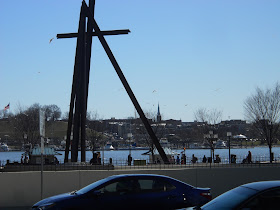The
views offered by Pratt St. are truly breathtaking and have only
improved since the influential Harbor Place Shopping Mall and the Harbor
Promenade opened in 1980. Many new developments, redevelopments, and
Neighborhoods have built been as a result of Pratt St. and have begun to
take the shine off of Pratt St. and to keep it as the City's true
showcase, Pratt St. must be looked at comprehensively to fix what
doesn't work and emulate what does. Luckily, Pratt St. seems to be on
the right track.
This begs the questions; What
is the right track? What is the wrong track? In what way is Pratt St. on
the right track? In what way is Pratt St. on the wrong track? And most
importantly, how does what's on the wrong track get moved to the right
track? The answer to these questions boils down to simply one word:
Retail. Retail will put Pratt St. on the right track.
When
the Inner Harbor was in its infancy, Retail was contained to Harbor
Place. At the time, this was sufficient because this island of
gentrification was too small and many of the now glitzy Residential
Neighborhoods were decades away from rebirths. Other than Harbor Place,
Pratt St. was contained to housing Office Buildings, Hotels, and the
Convention Center. Pratt St's Office Buildings however were a breath of
fresh air due to their relative accessibility as compared to Charles
Center whose buildings enclose in on each other.
As
higher density development continued around the Harbor, the buildings
became more and more mixed use. Whether it was Offices, Residences, or
Hotel Rooms in the upper floors, one thing remains constant; Ground
Floor Retail. When creating a higher density urban core which is what
these developments are doing (including Pratt St.) it is crucial to get
large volumes of foot traffic day and night. Retail plays the biggest
part in creating that synergy.
Parts of
Pratt St. are on the right track while others are on the wrong track. In
layman's terms that means that some buildings have mastered the art of
ground floor Retail while others haven't quite gotten the hang of it.
Much of this depends greatly on the age of the building and/or whether
or not it has gone through major renovations.
Now
lets take a look at some buildings. Here are the Pandora and Bank of
America Buildings. Both buildings provide a great view of the water and
are offered lots of foot traffic from Tourists and Residents alike just
inches away from such attractions as Harbor Place, The Convention
Center, The National Aquarium, and Camden Yards to name a few. Both of
these Buildings do have a Retail component in them however how it's laid
out leaves much to the imagination. To access said Retail, you have to
inside the Building.
There are no exterior
entrances to the Retail. Worse yet, the very wide setback of the
buildings decreases road visibility. This makes for Retail that doesn't
draw in outsiders and restricts their customer base to Office Tenants.
On the weekend this proves even more daunting as no other purpose draws
masses into these buildings as most of the Offices are closed. As you
could imagine, there are vacancies in the Retail spaces.
The
PNC Building across the street however, got it right. Although this is
an older building in the timeline of Pratt St.'s, the Retail spaces have
their own separate entrances so nobody has to go in the Office
Building. There are four Retail bays on the ground floor of this
building including Sullivan's Stake House, Kona Grill, and of course a
PNC Bank Branch while the 4th space is available for lease.
The
R2Integrated Building, formerly the City Paper Building, was a lot less
Retail oriented until they built an addition that now houses some of
Pratt St's hottest Retail attractions including Shake Shack. The owners
of this owner building knew that newer is better when it comes to
attracting Retailers and the success story can be transferred to
building like the Bank of America Building and Pandora Building.
Newer
Buildings on Pratt St. are easier to pick out due to the fact that they
don't have the very wide sidewalks in front of them and have greater
road visibility. They also have modern Ground Floor Retail built into
them lake Lockwood Place and the adjacent Lockwood Plaza.
Lockwood
Plaza's very unique in that it features traditionally big box stores in
a compact urban concept. It has however had its shares of ups and
downs. It had once hosted a Fielene's Basement and a Best Buy in the
second and third floors respectively, but both have since closed.
Marshall's took over the second floor while the third floor remains
vacant. I would love to see a tenant like Nordstrom Rack take over the
third floor.
The last building we're profiling
is the Constellation Energy Building. This is another newer Pratt St.
Building whose entire ground floor Retail space is taken up by the
hugely successful Ms. Shirley's Cafe. One reason I'd like to mention the
success of Ms Shirley's is because the main tenant of its Office
Building will be vacating it soon. Exelon, the parent company of
Constellation Energy is currently building a brand new headquarters in
Harbor Point.
Ms. Shirley's has a large enough
draw that it will remain successful until their office building is
refilled. If the Bank of America Building were to lose a large tenant
like that, the interior food court style Retail spaces would be doomed.
That shows how crucial it is to update for outdoor access Retail spaces
while increasing roadside visibility. Then and only then, can Pratt St.
be completely on the right track.















No comments:
Post a Comment